Description of the flavor and aroma characteristics of the sweet San Juan coffee beans in Honduras
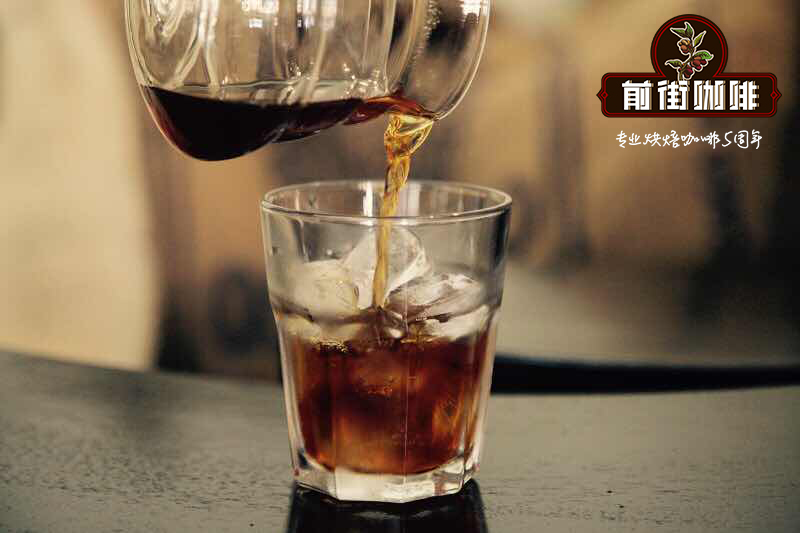
Professional coffee knowledge exchange more coffee bean information please follow the coffee workshop (Wechat official account cafe_style)
What we want to share today is Honduras from Central America, a mountainous country that borders Guatemala, Nicaragua and El Salvador as a neighbor, with a coastline between the Pacific Ocean and the Caribbean. However, there is no record of the history of coffee cultivation in Honduras, but it is generally believed to have been introduced by a Spanish businessman in the 18th century.
Honduras is located in the north of Central America, facing the Caribbean Sea to the north, the Gulf of Fonseca in the Pacific Ocean to the south, Nicaragua and El Salvador to the east and south, and Guatemala to the west, mostly mountains and plateaus. With a tropical climate, mild temperature and abundant rainfall, it is an ideal place for coffee growth.
For coffee production, the geographical conditions of Honduras are no less than those of neighboring coffee-producing countries such as Guatemala and Nicaragua. There are 280000 hectares of coffee plantations in Honduras, mainly small coffee plantations, most of which are less than 3.5ha. These coffee plantations account for 60 per cent of all coffee production in Honduras.
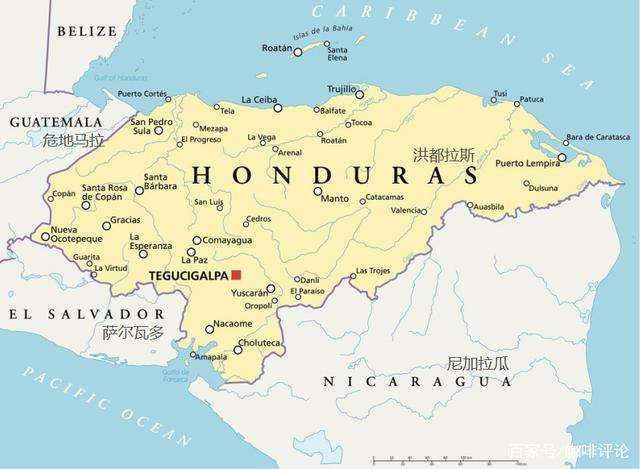
There are six main coffee producing areas in Honduras, including Santa Barbara, Copan, Ocotepeque, Lempira, La Paz and El Paraiso in the southeast. Honduran coffee tastes less acidic, while caramel is more sweet. The taste of coffee from these five different producing areas is also slightly different, some slightly sour, some have a unique flavor. Its quality is not bad at present, but because it is still promoting its popularity, the price of coffee in the country is actually quite competitive.
Honduran coffee seems strange to many coffee drinkers.
The granules of coffee beans in Honduras are large in shape, uniform in size and glossy in color. In order to facilitate harvesting, farmers will trim the coffee trees to no more than 150 centimeters, because if they grow too high, they have to set up ladders to pick, which is not only time-consuming, but also may damage the trees by bending branches. As the ripening period of each fruit of coffee beans is different, in order to maintain the good quality of coffee beans, it is necessary to pick them manually, and then select the ripe fruits. For coffee fruits of the same branch, it often takes several weeks to pick them all.
When it comes to coffee production, the geographical conditions of Honduras are no less than those of neighboring coffee-producing countries such as Guatemala and Nicaragua. However, in the past, Honduras was less well-known in the consumer market because it did not have strong support in the handling and transportation of raw beans. However, in recent years, the country has begun to change dramatically, and the emphasis on the coffee industry has slowly opened up the international popularity of coffee from Honduras.
High-quality coffee in Honduras uses water washing to deal with coffee beans, usually after soaking, when the defective fruit will surface, it can be discarded first. Then put the good fruit into the fruit peeling machine and peel off the peel with the rotating force of the machine. Peeled fruits are screened by machines to select fruits of high quality. Usually the bigger the fruit, the better the maturity. Coffee in Honduras is dried in the sun, so there is always a hint of fruity in the taste.
The granules of coffee beans in Honduras are large in shape, uniform in size and glossy in color. In order to facilitate harvesting, farmers will trim the coffee trees to no more than 150 centimeters, because if they grow too high, they have to set up ladders to pick, which is not only time-consuming, but also may damage the trees by bending branches. As the ripening period of each fruit of coffee beans is different, in order to maintain the good quality of coffee beans, it is necessary to pick them manually, and then select the ripe fruits. For coffee fruits of the same branch, it often takes several weeks to pick them all.
High-quality coffee in Honduras uses water washing to deal with coffee beans, usually after soaking, when the defective fruit will surface, it can be discarded first. Then put the good fruit into the fruit peeling machine and peel off the peel with the rotating force of the machine. Peeled fruits are screened by machines to select fruits of high quality. Usually the bigger the fruit, the better the maturity. Coffee in Honduras is dried in the sun, so there is always a hint of fruity in the taste.
For coffee production, the geographical conditions of Honduras are no less than those of its neighboring coffee-producing countries such as Guatemala and Nicaragua. There are 280000 hectares of coffee plantations in Honduras, mainly small coffee plantations, most of which are less than 3.5ha. These coffee plantations account for 60% of the total coffee production in Honduras. In the coffee garden, because the planting area belongs to the mountain area, people pick coffee beans by hand, and then process them carefully in order to produce better quality coffee beans. Honduras collects 3 million bags of coffee every year and provides you with multi-quality coffee. It has become one of the top ten coffee exporters in the world.
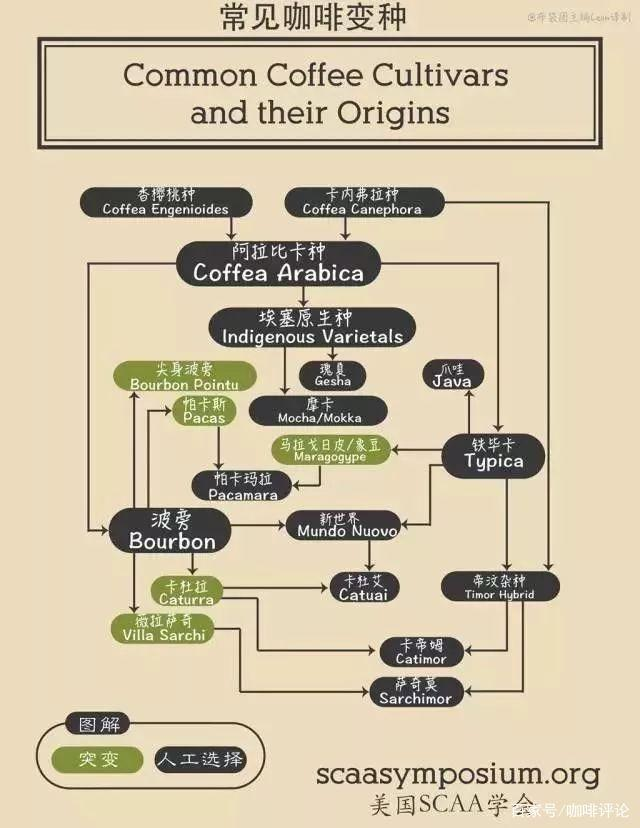
Most of the coffee varieties grown in Honduras are Arabica, mainly derived from Bourbon Bourbon, Kaddura Caturra, Kaduai Catuai, Iron pickup Typica and Pacas Pacas.
Typica tin card: the oldest native variety in Ethiopia, all Arabica are derived from Tibika. The top leaf of Tiebika is bronzed and the bean body is oval or thin in shape; the flavor is elegant, but the physique is weak, the disease resistance is poor and the fruit yield is less.
Borbon bourbon: a variety mutated from Typica, which, like Typica, is currently the closest to the original species. Bourbon spread from southwestern Ethiopia to Yemen and was brought to the island of bourbon (now Reunion) from Yemen in 1715 and 1718. Bourbon produces 2030% more fruit than Typica.
Caturra Kaddura: native to Brazil, is a variety of bourbon. Kaddura is a short and dense coffee species, which is more convenient to harvest and take care of. The branch and the trunk also show a 45-degree angle. The leaves are round and shiny! The shape of the fruit is similar to that of bourbon, but the yield per plant is higher, the harvest time is later, and the trunk is more resistant to the wind!
Catuaikaduai seed: it also comes from Brazil. It's a hybrid of Mundo Novo and Caturra.
Maracatu Malakadura: a hybrid of Maragogype and Caturra, with a larger bean shape.
The grading system of coffee in Honduras adopts the classification system of altitude and defect rate, in which the classification of defect rate is divided into two standards: the United States and Europe.
Altitude

Defect rate classification

Appearance and flavor Honduran coffee bean particles are large in shape, uniform in size, uniform in color and glossy. Honduran coffee has a rich and mellow taste, taste is not astringent, not sour, mellow and aroma are very high, quite personality.
Washing method the high-quality coffee in Honduras uses the washing method to treat the coffee beans, usually after soaking, the defective fruit will surface and can be discarded first.
Then put the good fruit into the fruit peeling machine and peel off the peel with the rotating force of the machine. Peeled fruits are screened by machines to select fruits of high quality. Usually the bigger the fruit, the better the maturity. Honduran coffee is dried in the sun, so there is always a hint of fruit in the taste.
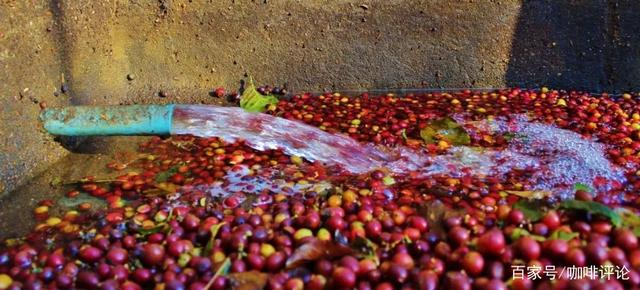
[front Street Coffee Honduras San Juan Heido Coffee beans]
Country: Honduras
Origin: San Juan Xido producing area
Manor: Finca Altos de Erapuca of Otos Manor
Altitude: 1300m
Variety: Kaduai
Treatment: Washed washing
[front street cooking method] display filter cup: V60 filter cup
Water temperature: 88-89 degrees
Degree of grinding: small Fuji grinding 4
Powder / water ratio: 1:15
Washing and cooking technique
The steaming time is 30 seconds, and the amount of water injection is 30-125-225 grams.
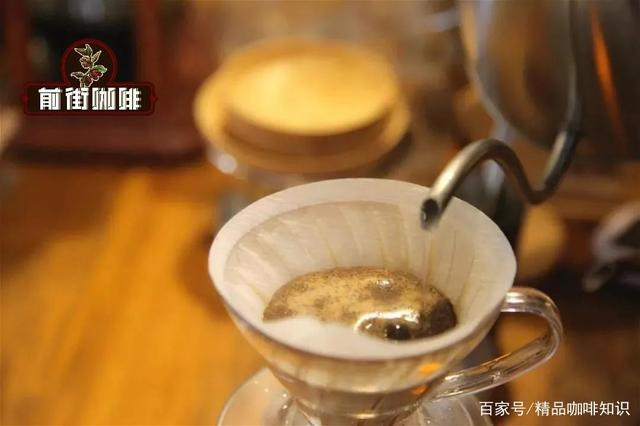
Cooking analysis
San Juan likes to bake a little deeper, in order to reduce the release of bitterness, choose to use coarse sugar grinding degree, lower water temperature, extract full texture of coffee liquid, fully show its caramel, cream, nut sweetness.
Steaming and water injection in the first stage, stick to the powder layer as far as possible, at this time, the coffee powder absorbs water and expels vigorously, the gap of the powder particles is large, the water column is too high, it is easy to pass through the coffee powder at once, and does not fully participate in the extraction, and when the water column is injected into the second stage, the height of the water column can be increased in order to stir the fine powder at the bottom of the filter cup and reduce blockage.
Important Notice :
前街咖啡 FrontStreet Coffee has moved to new addredd:
FrontStreet Coffee Address: 315,Donghua East Road,GuangZhou
Tel:020 38364473
- Prev
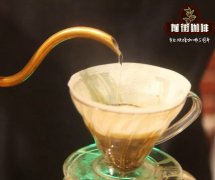
Why is Brazilian Rio coffee called Golden Rio? what's its flavor?
Professional coffee knowledge exchange more coffee bean information Please pay attention to the coffee workshop (Wechat official account cafe_style) Brazil is the world's number one coffee producer, the coffee produced, mild flavor, slightly sour, slightly bitter, the representative of neutral coffee. Sour and bitter taste can be blended by baking. Moderate baking has a soft flavor and moderate taste, while deep baking has a strong bitter taste, which is a blending temperature.
- Next

Kenya Carrogoto AATO Carloto Karogoto Coffee beans overall flavor
Professional coffee knowledge exchange more coffee bean information Please follow Coffee Workshop (Wechat official account cafe_style) Kenya Karogoto AA Top this year is definitely a year of coffee explosion in Kenya, not only new stars like the previously introduced Gondor, some established processing plants are also more delicate and rich in the presentation of flavor. Both H and P have been involved in domestic bean merchants.
Related
- Detailed explanation of Jadeite planting Land in Panamanian Jadeite Manor introduction to the grading system of Jadeite competitive bidding, Red bid, Green bid and Rose Summer
- Story of Coffee planting in Brenka region of Costa Rica Stonehenge Manor anaerobic heavy honey treatment of flavor mouth
- What's on the barrel of Blue Mountain Coffee beans?
- Can American coffee also pull flowers? How to use hot American style to pull out a good-looking pattern?
- Can you make a cold extract with coffee beans? What is the right proportion for cold-extracted coffee formula?
- Indonesian PWN Gold Mandrine Coffee Origin Features Flavor How to Chong? Mandolin coffee is American.
- A brief introduction to the flavor characteristics of Brazilian yellow bourbon coffee beans
- What is the effect of different water quality on the flavor of cold-extracted coffee? What kind of water is best for brewing coffee?
- Why do you think of Rose Summer whenever you mention Panamanian coffee?
- Introduction to the characteristics of authentic blue mountain coffee bean producing areas? What is the CIB Coffee Authority in Jamaica?

